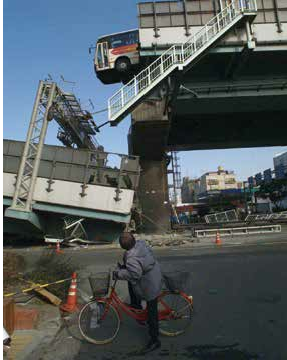Issue:
At the time, it was the worst earthquake postwar Japan had ever experienced. It became a lesson for a disaster-prone country.

ON MONDAY, JAN. 12, thousands of 20 year olds will celebrate “Seijin no Hi,” their official passage into adulthood.
For Kobe, this year’s ceremony is especially significant because it honors the first adults who were born the same year the Great Hanshin Earthquake struck on the morning of Jan. 17, 1995. A new generation with no memory of the earthquake, or what the city was like before it, has come of age.
For journalists like myself who covered the quake not as reporters who parachuted in, but as local hacks for whom Kansai was home, the memories remain vivid. The emotions we experienced grief, joy, anger, and, like our Kobe friends, determination to get on with our lives profoundly shaped the way we would approach our craft in the years to come. Not a few of us watched with shock and horror at the central government’s initially incompetent, and occasionally callous, response. A deep skepticism was born of the Tokyo political, bureaucratic and media chattering classes that persist to this day.
Thus few of us were surprised that victims of the March 11, 2011 quake and tsunami had many of the same complaints about the central government as Kobe had 20 years ago. Thankfully, the Kobe earthquake also led to fundamental changes that allowed for a more effective response to Tohoku.
Perhaps the most important was to be able to call out for assistance to individuals as well as NGOs from other parts of Japan. Before the Kobe quake, NGOs had something of, if not a bad name, then at least an image of not being something that ambitious and respectable middle class Japanese took an interest in.
“Volunteerism” for the upper middle and upper classes at least meant helping the unfortunate in distant, exotic, developing countries. It took the Kobe quake to make people realize that the Tokyo politicians and bureaucrats who they’d assumed would automatically take care of things, simply would not, or could not, handle the situation in a timely manner. The scenes of devastation woke people up to the fact that a city in their own country, not Africa, or some country in Southeast Asia, desperately needed their volunteer efforts.
Many who came together to help Kobe in 1995 remained friends long afterwards. Out of their initial efforts, volunteer networks grew, splintered off, grew again and expanded. Local governments became less obstinate and more cooperative with certain kinds of NGOs, eliminating official rules and, more importantly, overcoming the kind of bureaucratic mistrust and turf wars that had prevented official coordination with volunteers. Kobe and Hyogo Prefecture became models for disaster response measures for local governments around Japan.
The Kobe quake also helped spark a technical revolution. In early 1995, cell phones and PHS systems (remember those?) were available, but were not in widespread use, at least in Kansai as they were expensive and apt to lose their signal whenever you passed under a bridge, walked into a subway station, or found yourself in a concrete building far away from a window, most people used landlines.
But when landlines became inoperable after the quake, cell phone sales skyrocketed. Suddenly, it seemed, just a few weeks after the quake, everybody in Kobe was chatting on a cell phone, which, it was eventually decided, was better than a PHS in case there was an emergency.
For Kobe itself, the quake left a mixed legacy. The world marveled at how quickly physical reconstruction occurred and how quickly people returned to their normal lives. In many respects, the city looks far better today than it did before the earthquake new buildings, more diverse, higher quality restaurants, cafés and shopping options. Lots of young people dressed, as Kobe has always dressed, in fashions that, depending on your taste and age, are either cutting edge or tacky. But never dull.
On the other hand, the earthquake further reduced Kobe’s already declining economic power, as firms and people relocated to Osaka, Tokyo or overseas. While the Kobe mosque and synagogue, several Christian churches, a foreigners’ graveyard, The Kobe Club, and the Kobe Regatta and Athletic Club, are visible reminders of Kobe’s historical ties to the outside world, there is a sense throughout Kansai that the city is more provincial now than before the quake.
Over the past 20 years, Kobe has struggled to keep up, and to distinguish itself as a place to study and work as well as live. This is not an easy task in a region where Osaka and Kyoto draw the most domestic and international attention. Sadly, much of the effort, and funding, was wasted on pork barrel projects like the Kobe airport.
Successful long-term disaster recovery depends upon many things. But near the top of the list is enlightened, realistic and (relatively) honest local governance. In that regard, Kobe’s record since 1995 is decidedly mixed.
Eric Johnston is deputy editor for the Japan Times Osaka bureau.

